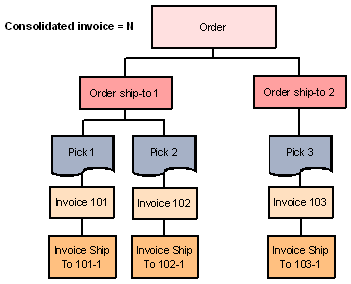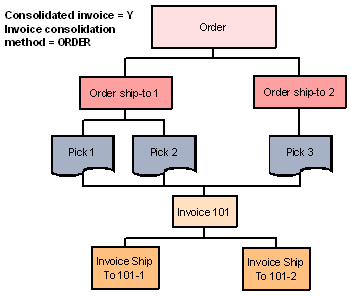Invoice Consolidation Method (E29)
Purpose: Use this screen to define whether to consolidate invoices for all ship-to addresses on an order, or only within the same ship-to address, for shipments that occur on the same system date.
Code field:
• ORDER = consolidate shipments on the same system date for all order ship-to addresses onto the same invoice.
• ORDER SHIP = consolidate shipments on the same system date onto the same invoice only if the shipments are for the same order ship-to address.
The system checks this setting only if the Consolidated Invoice (B49) system control value is selected.
Authorizations: The setting of this system control value and the Consolidated Invoice (B49) system control value controls the number of authorizations processed for an order.
• If Consolidated Invoice (B49) is unselected, the system generates a separate authorization request for each pick associated with the order.
• If Consolidated Invoice (B49) is selected, the system:
- If the Invoice Consolidation Method (E29) is set to ORDER, generates an authorization request across all picks for the order (across all ship tos on the order).
- If the Invoice Consolidation Method (E29) is set to ORDER SHIP, generates an authorization request across all picks for each order ship to on the order.
See Authorizations When Consolidating Invoices for more information.
Capture addresses? The Capture Addresses for Invoice (J24) system control value also plays a role in how to consolidate invoices if:
• the Consolidated Invoice (B49) system control value is selected, and
• there are multiple shipments for an order on the same system date, and
• the shipping or billing address changes between shipments. For example, you have an outstanding pick slip printed for an order. Before you generate an additional pick slip for the same order, the customer calls and changes the billing or shipping address. If you confirm shipment of both pick slips on the same system date, the change in billing or shipping address prevents the shipments from consolidating into the same Invoice Header or Invoice Ship To as they otherwise would:
- If the Invoice Consolidation Method is set to ORDER, and the billing or shipping address changes for an order ship-to between billing pick slips, the system consolidates the two pick slips onto the same Invoice Header number, but creates separate Invoice Ship To records.
- If the Invoice Consolidation Method is set to ORDER SHIP, and the billing or shipping address changes for an order ship-to between billing slips, the system creates a separate Invoice Header number and Invoice Ship To record for each pick slip.
Integration with the Sales Audit module of the Oracle Retail Merchandising Foundation Cloud Service: This system control value should be unselected if you use the Integration with the Sales Audit Module of the Oracle Retail Merchandising Foundation Cloud Service. If this system control value is selected, it is possible to generate multiple transaction heads for submission to the Sales Audit module of the Oracle Retail Merchandising Foundation Cloud Service with the transaction numbers, as individual lines on the order are billed. In the items that bill first could accumulate and repeat on each subsequent transaction: for example, if 3 items ship separately, invoice 1 contains item 1; invoice 2 contains items 1 and 2; invoice 3 contains invoice 1, 2, and 3.
Invoice Consolidation Examples
In the following examples, an order includes two ship-to addresses. There are two separate pick slips for the first ship-to address and a pick slip for the second ship-to address. All three pick slips ship and bill on the same system date. These examples illustrate the effects of the three related system control values.
Example 1: Consolidated invoice is unselected. In this situation, each pick slip produces a separate Invoice Header, each with a single Invoice Ship To record.

Example 2: Consolidated invoice is selected and Invoice consolidation method is ORDER. In this situation, all three pick slips are consolidated into a single Invoice Header number. There are two separate Invoice Ship To records, one for each order ship-to address.

Example 3: Consolidated invoice is selected and Invoice consolidation method is ORDER SHIP. In this situation, the pick slips for the first order ship-to address are consolidated into a single invoice and Invoice Ship To record. The pick slip for the second order ship-to address create a separate Invoice Header and Invoice Ship To.

Example 4: Consolidated invoice is selected, Invoice consolidation method is ORDER, and Capture addresses for invoice is selected. In this situation, if there is a different billing or shipping address on the second pick slip for the first order ship-to address, the separate shipping addresses for the first order ship-to are not consolidated onto the same invoice; however, the second shipping address for the first ship-to is consolidated onto the same Invoice Header number as the second ship-to, but there is a separate Invoice Ship To for each.

Example 5: Consolidated invoice is selected, Invoice consolidation method is ORDER SHIP, and Capture addresses for invoice is selected. In this situation, if there is a different billing or shipping address on the second pick slip for the first order ship-to address, the different addresses prevent any invoice consolidation. Each separate pick slip produces a separate Invoice Header number and Invoice Ship To.

